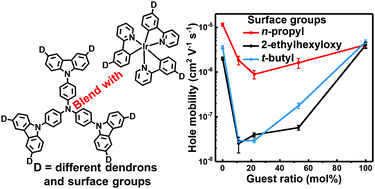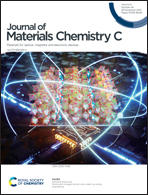Effect of dendron structure on the luminescent and charge transporting properties of solution processed dendrimer-based OLEDs†
Abstract
The photophysical and charge transport properties of neat and blend films of fac-tris[2-phenylpyridinato-C2,N]iridium(III) [Ir(ppy)3]-cored light-emitting dendrimers and tris(4-carbazoyl-9-ylphenyl)amine (TCTA)-based hosts, with each combination having the same first generation dendrons were measured and compared. The first generation dendrons were composed of bis(fluorenyl)carbazolyl with n-propyl surface groups, or biphenyl with 2-ethylhexyloxy or t-butyl surface groups. Dendronisation of the emitter and host was found to decrease the energy transfer efficiency from the host to the guest relative to an evaporated Ir(ppy)3:TCTA blend film, with the blend composed of materials with biphenyl dendrons and t-butyl surface groups having the largest decrease. The hole mobilities of the solution processed neat and blend layers were found to be 1–2 orders of magnitude lower than those of the equivalent evaporated films. The blend film containing the host and dendrimer with first generation biphenyl dendrons and 2-ethylhexyloxy surface groups had the highest photoluminescence quantum yield (PLQY), comparable to evaporated Ir(ppy)3:TCTA-based films but the lowest hole mobility (≈10−8 cm2 V−1 s−1). In contrast, the blend with the dendrimers composed of the bis(fluorenyl)carbazolyl dendrons with n-propyl surface groups had a low PLQY but higher hole mobility. It was found for the combinations of these solution processable materials that the hole mobility of the blend film was the limiting factor in OLED performance. Devices containing an emissive layer of the materials with the bis(fluorenyl)carbazolyl dendrons with n-propyl surface groups (11 mole percent of the emitter) had a PLQY of 40.8% but the highest external quantum efficiency of 10.0 ± 0.4%, reaching a maximum luminance of almost 10 000 cd m−2.

- This article is part of the themed collection: Special issue in honour of Seth Marder


 Please wait while we load your content...
Please wait while we load your content...